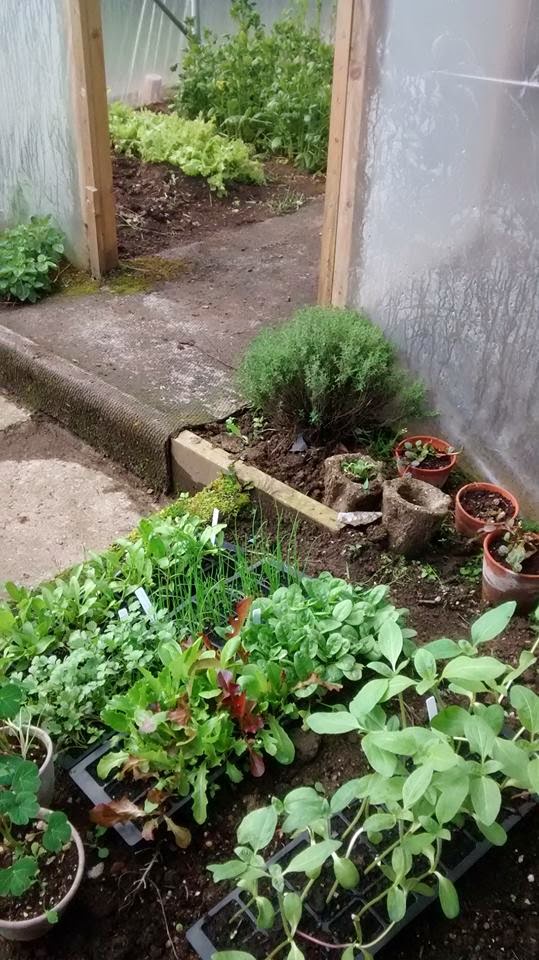The polythene tunnel is overflowing, so much so that I have
had to put a lot of trays outside. I’m not complaining of course as it’s a sure
sign that everything is at full speed growing and germinating. The multi cell
trays I have outside have mostly small plants that will be ready to plant into
the vegetable patch as soon as I am confident there will be no more frosts,
(apparently we don’t get frosts after the 8th of May according to
the bloke who owned Ness Nursery).
The runner beans especially are large enough and are rooting
into the ground almost immediately wherever I put them. I have all of the
bamboo structures in place so it won’t be any bother to get them out of the
confines of the cells and into the ground. (Job to do number 200 in the garden)
I need to just go over the soil where the other plugs are going to be planted;
I’m not too fussy about weeds in the garden as long as the vegetables get a
head start to cut down on the competition for nutrients in the soil.
I have new spinach and lettuce coming along in trays. I have
some of these growing in the tunnel, along with peas and chard from last year
and they have been great at supplying me with fresh greens to put into my
blender in the mornings. There needn’t be any time in the year when the tunnel
isn’t producing something to make into a blended drink, but the plants are
starting to go to seed so I have cleared half of them to make way for fresh
summer stock. I thought I might as well collect some of the seeds myself and
plant them later in the year for another winter crop. I also have left one land
cress plant in as I quite liked those blended too and I have self-set rocket
but that’s a bit strong for the blender. The chard will probably all go as I
have new plants coming along in the garden, they are from the same batch as the
tunnel ones but because they have had to endure the rigours of winter out of
doors they show no sign of going to seed just yet like the tunnel grown ones
do.
I’ve added a lot of garden compost to the soil in the
tunnel. It’s full of worms and a bit smelly but it’s needed to keep the
nutrients up for the next batch of plants. I am finding bits of plastic bags, bread
bag ties and other non-compostable things as I add the compost. I think this is
an indication of putting things in the compost bin in bad weather and not
looking or it could be a sign of not concentrating on what I am doing when I’m
in the kitchen.
This is probably the reason we find car keys in the fridge and
shoes in the oven, everyone does that …right?
Self Set
I found a lot of self-set tomatoes in the patch where the
spinach grew. When the tomatoes finished
in winter I just dug the soil and any dropped fruit was just covered over. For
once my untidiness paid off as lots of new plants have emerged. I am growing a
few on, but not many though as we weren’t that fussed about the variety we grew
last year. I have some of Klaus’s ‘Sweet Aperitif’ type so they will be my main
crop this year. Still it’s nice to get some freebies.
My trays of 60 cacti and succulents have been transferred
from the windowsill in the porch and into the tunnel. Overwintering them in the house paid
dividends as they are, or were, looking very healthy. Since they have been in
the tunnel their appearance has gone downhill a bit as the leaves are discolouring
and some are looking a bit shabby. I should be pleased though as this is what
the plants would look like if they were growing in the wild and not in a
controlled environment. It’s like reverting them back to their original state.
I was hoping to sell them on in garden centre quality but it looks like I’m
stuck with them now. It’ll be a challenge finding somewhere in the house for
them in winter as they will be in 60 individual pots by then!
Chamomile
My chamomile lawn plants came this week, bare rooted in a
plastic bag. They looked great as I planted them into individual pots but are
needed a bit of TLC to rejuvenate them so I have them under plastic in the
tunnel for a week or two. I’m not sure what to do with them yet, maybe I’ll
make a lawn. I’ll add it to the list of
jobs to do in the garden (number 276)


